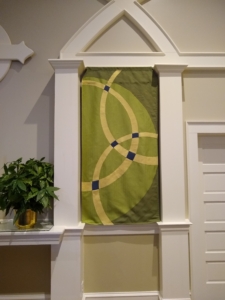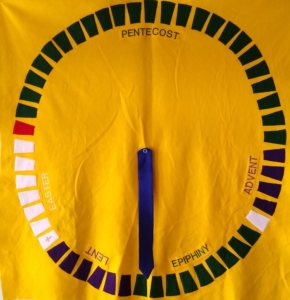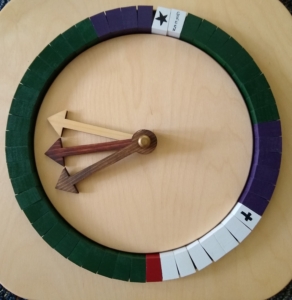 One of the first things the children of the church notice in the sanctuary is the liturgical color. When the season changes, when stoles and paraments move from purple to white or white to red or green to purple, they usually point that out before I can even get to it in the children’s sermon (remember those?). But, in reality, we all notice. We all see that something is different. It could be the light falling through the windows at a different angle (be sure to sit on the left-hand side of the sanctuary right after daylight saving time, or at least be sure the shade is down). It could be the wreath that comes along with Advent or flaming streamers at Pentecost. Whatever the change is, the color reminds us of stories and events that mark the passage of time in our own lives just as they reveal the Biblical story.
One of the first things the children of the church notice in the sanctuary is the liturgical color. When the season changes, when stoles and paraments move from purple to white or white to red or green to purple, they usually point that out before I can even get to it in the children’s sermon (remember those?). But, in reality, we all notice. We all see that something is different. It could be the light falling through the windows at a different angle (be sure to sit on the left-hand side of the sanctuary right after daylight saving time, or at least be sure the shade is down). It could be the wreath that comes along with Advent or flaming streamers at Pentecost. Whatever the change is, the color reminds us of stories and events that mark the passage of time in our own lives just as they reveal the Biblical story.
C.S. Lewis once wrote a book called, The Screwtape Letters, imagining the kind of advice a demon might give to a young charge hoping to steal a soul away from God. (Interestingly, a clergyman without a sense of humor complained to the paper publishing the letters, wondering why someone was giving such “devilish advice.”)
Screwtape, the one giving advice, talks about “The horror of the Same Old Thing”—our great fear that nothing will change, and therefore we, as people, crave variety. Says Screwtape, “The horror of the Same Old Thing is one of the most valuable passions we have produced in the human heart—an endless source of heresies in religion, folly in counsel, infidelity in marriage, and inconstancy in friendship. The humans live in time, and experience reality successively. To experience much of it, therefore, they must experience many different things; in other words, they must experience change.”
The demon laments the way the universe is ordered, claiming that God gives us the best of both worlds—change and permanence: “He has balanced the love of change in them by a love of permanence. He has contrived to gratify both tastes together in the very world He has made, by that union of change and permanence which we call Rhythm. He gives them the seasons, each season different yet every year the same, so that spring is always felt as a novelty yet always as the recurrence of an immemorial theme.”
We delight in the change of season—some cooling rains in August spell a welcome change, anticipating vibrant leaves and bright Autumnal skies. We do the same at church—who doesn’t love the return of Christmas carols, or Easter lilies? We love them because they’re beautiful. We love them because they remind us that Christ came for us, and Christ was raised for us.
In the long middle of the year we get less change. We get “Ordinary Time.” We get green that seems to blend in with the furniture. We no longer notice the change. (Not a bad color for this long season when we can’t be together, is it?)
Thanks to our worship team, however, we now have something else to notice and appreciate hanging in the back of our church. Two new banners will grace the sanctuary, drawing our eyes to the cross, reminding us of the season in time where God is still—and always will be—present. The banners provide a dynamic angle of a triquetra, an ancient Trinitarian symbol reminding us of divine love in communion as we understand God to be Father, Son, and Holy Spirit. As our church borrows this symbol—as well as our logo, a celtic knot comprised of several triquetras in the shape of a cross—we remember our communion, too—together despite the fact that we are apart.
Many thanks to Jeane Jones who led this effort; to Laura Allgood who coordinated; to Kathryn Sellers who sewed triquetras on our new matching paraments; and to Priscilla Brown, who designed and made the banners (and to Mike Brown, who helped a little, too).
The green of ordinary time symbolizes the nurture and growth of the life of faith thanks to the grace of Jesus and the presence of the Holy Spirit. It reminds us that—even as the season slows—the grace of God is with us, changing us, even if we can’t always see it right away.


Get Social